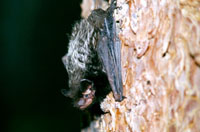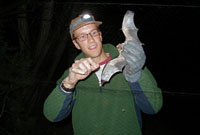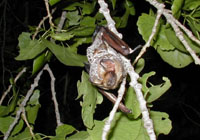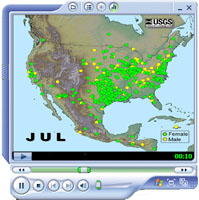 In the push to develop new forms of sustainable energy, the wind power industry is at the forefront. Turbines that harness the power of wind already serve as effective power sources across the globe, and this proven effectiveness has led to vast increases in the number of turbines currently under construction. The general impact of wind turbines on the environment is likely far less than that of conventional power sources. However, recent evidence shows that certain species of bats are particularly susceptible to mortality from wind turbines. Bats are beneficial consumers of harmful insect pests, and migratory species of bats cross international and interstate boundaries.
In the push to develop new forms of sustainable energy, the wind power industry is at the forefront. Turbines that harness the power of wind already serve as effective power sources across the globe, and this proven effectiveness has led to vast increases in the number of turbines currently under construction. The general impact of wind turbines on the environment is likely far less than that of conventional power sources. However, recent evidence shows that certain species of bats are particularly susceptible to mortality from wind turbines. Bats are beneficial consumers of harmful insect pests, and migratory species of bats cross international and interstate boundaries.
Dead bats are turning up beneath wind turbines all over the world. Bat fatalities have now been documented at nearly every wind facility in North America where adequate surveys for bats have been conducted, and several of these sites are estimated to cause the deaths of thousands of bats per year. This unanticipated and unprecedented problem for bats has moved to the forefront of conservation and management efforts directed toward this poorly understood group of mammals. The mystery of why bats die at turbine sites remains unsolved. Is it a simple case of flying in the wrong place at the wrong time? Are bats attracted to the spinning turbine blades? Why are so many bats colliding with turbines compared to their infrequent crashes with other tall, human-made structures?
 |
 |
| Hoary bats (Lasiurus cinereus; left) and Silver-haired bats (Lasionycteris noctivagans; right) are showing up dead beneath wind turbines all across North America. Photos by Paul Cryan and Keith Geluso. |
|
 |
 |
USGS Research Biologist Paul Cryan takes a female hoary bat out of a net. This bat was intercepted during its spring migration through New Mexico. Photo by Leslie Cryan. |
Like this hoary bat (Lasiurus cinereus), most of the bats killed by wind turbines roost in trees during summer. Photo by Paul Cryan. |
Although these questions remain unanswered, potential clues can be found in the patterns of fatalities. Foremost, the majority of bats killed by wind turbines are species that rely on trees as roosts throughout the year and migrate long distances; we call these species “migratory tree bats.” Currently, migratory tree bats compose more than three quarters of the bat fatalities observed at wind energy sites. The other striking pattern is that the vast majority of bat fatalities at wind turbines occur during late summer and autumn. This seasonal peak in fatalities coincides with periods of both autumn migration and mating behavior of tree bats. Seasonal involvement of species with shared behaviors indicates that behavior plays a key role in the susceptibility of bats to wind turbines, and that migratory tree bats might actually be attracted to wind turbines.
Despite patterns indicating that bat fatalities at turbines are somehow associated with migration and mating behavior, and that attraction may occur, these hypotheses have not been tested. At present, it is unclear whether bats killed by turbines are local residents, migrants moving through the area, bats actively mating, or some combination of these things. Further complicating matters is the fact that some of the species that die in smaller numbers at wind turbines are not known to migrate, although migratory habits of many bat populations are unknown and some of these species may actually do so. Addressing these important topics is crucial to future efforts aimed at mitigating the impact of wind turbines on bat populations. Knowing whether most of the bats killed by wind turbines are actively migrating, mating, or attracted to turbines will make it easier to direct effective mitigation efforts and assess risk before turbines are built.
The USGS is well-poised to answer questions regarding tree bat migration, behavior, and geographic origins. A cross-disciplinary (biology, geology, and geography) approach has put USGS scientists at the forefront of research into bat migration, behavior, and distribution (see Paul Cryan publications). For example, prior work by the USGS on the three bat species that die most frequently at wind turbine sites in North America has provided the most comprehensive picture, to date, of their migratory movements across the continent. These distributions have been mapped, as documented in the following links:

![]() Seasonal distribution of hoary bats (Lasiurus cinereus) [WMV format: 1.8 MB]
Seasonal distribution of hoary bats (Lasiurus cinereus) [WMV format: 1.8 MB]
![]() Seasonal distribution of silver-haired bats (Lasionycteris noctivagans) [WMV format: 1.7 KB]
Seasonal distribution of silver-haired bats (Lasionycteris noctivagans) [WMV format: 1.7 KB]
![]() Seasonal distribution of red bats (Lasiurus borealis and L. blossevillii) [WMV format: 1.9 KB]
Seasonal distribution of red bats (Lasiurus borealis and L. blossevillii) [WMV format: 1.9 KB]
One research tool that is particularly well-suited to studying the origins of bats killed at wind turbines is stable isotope analysis. USGS scientists recently pioneered the application of stable hydrogen isotope analysis to the study of migration in terrestrial mammals and proved the efficacy of the technique for studying the continental movements of bats. Coincidentally, this groundbreaking research focused on the very same species of bat (the hoary bat, Lasiurus cinereus) that is killed most frequently at wind turbine sites across North America. Efforts are now underway at USGS to expand the existing framework of stable isotope data on migratory tree bats and apply this technique toward uncovering some of the mystery surrounding bat fatalities at wind turbines.
Continuing on this prior trajectory, USGS scientists at the Fort Collins Science Center developed an active research program to investigate the causes and consequences of bat fatalities at wind turbines. Our specific focus is on (1) determining the geographic origins of killed bats and (2) assessing the potential roles of mating and feeding behaviors in the susceptibility of tree bats to deadly encounters with wind turbines. With expertise and experience studying bat migration and behavior, combined with an existing infrastructure that promotes collaboration between disciplines, the USGS is well-equipped to effectively address the problem of bat mortality at wind power facilities. Only through further research will we make progress toward minimizing the impact of this new form of sustainable energy on our Nation’s wildlife.
To learn more about this work or opportunities to collaborate, contact
Paul Cryan
USGS Fort Collins Science Center
2150 Centre Ave., Bldg. C
Fort Collins, CO 80526-8118
Tel. 970.226.9389
Fax 970.226.9230
Email cryanp@usgs.gov
![]() Overview of issues related to bats and wind energy
Overview of issues related to bats and wind energy
![]() Wind energy: A scare for bats and birds [audio podcast]
Wind energy: A scare for bats and birds [audio podcast]
![]() Economic importance of bats in agriculture
Economic importance of bats in agriculture
![]() Stable hydrogen isotope analysis of bat hair as evidence for seasonal molt and long-distance migration
Stable hydrogen isotope analysis of bat hair as evidence for seasonal molt and long-distance migration
![]() Monitoring trends in bat populations of the United States and territories: problems and prospects
Monitoring trends in bat populations of the United States and territories: problems and prospects
![]() Seasonal distribution of migratory tree bats (Lasiurus and Lasionycteris) in North America
Seasonal distribution of migratory tree bats (Lasiurus and Lasionycteris) in North America
![]() The use of stable isotopes to trace the migration of United States tree bats
The use of stable isotopes to trace the migration of United States tree bats
![]() Flying by night: USGS scientists put technology to work on bats
Flying by night: USGS scientists put technology to work on bats
![]() Linking migratory shorebird habitats: The power of stable isotopes
Linking migratory shorebird habitats: The power of stable isotopes